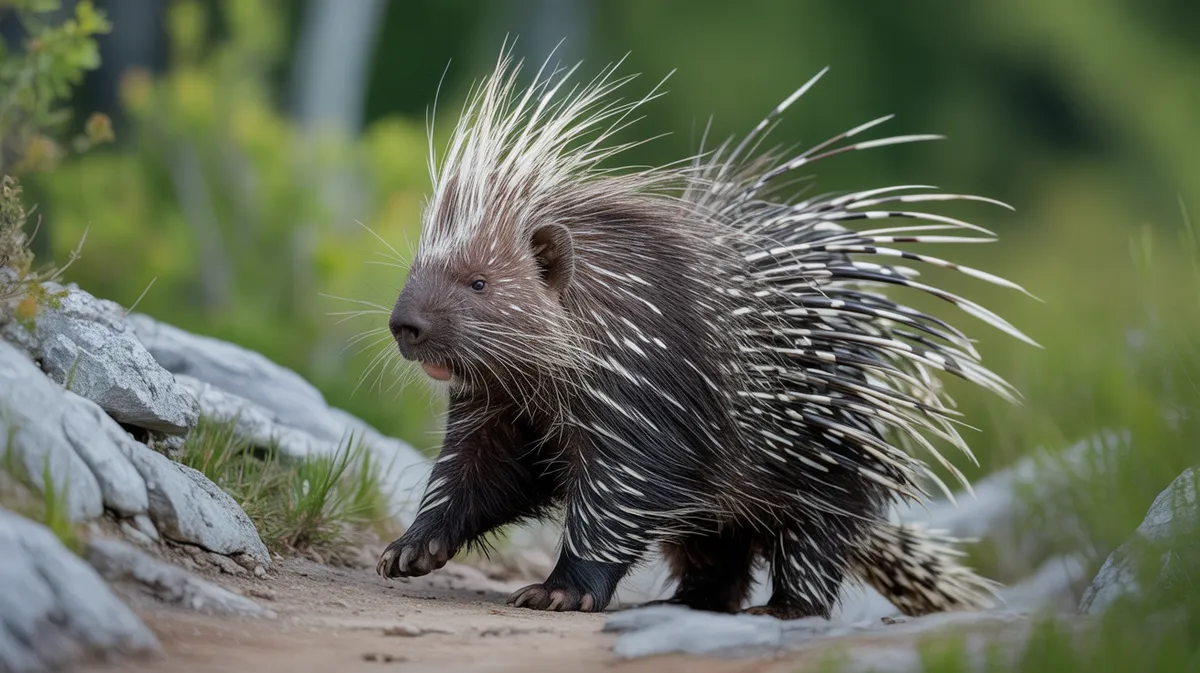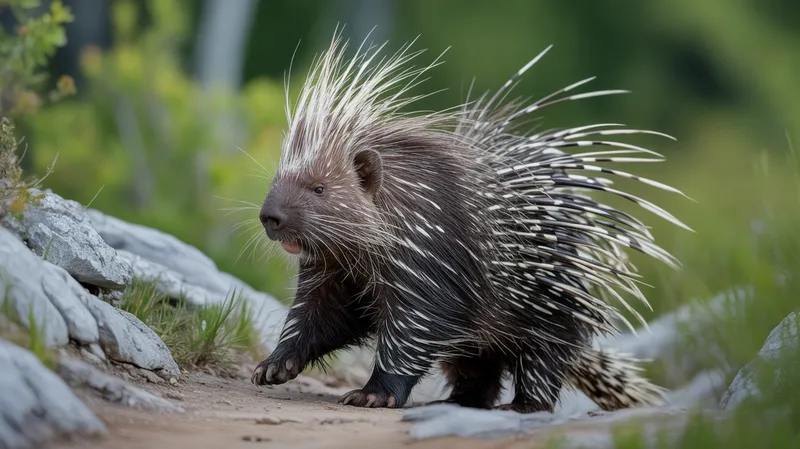
Crested Porcupine
Hystrix cristata

Meet the Crested Porcupine
The Crested Porcupine is a large, nocturnal rodent known for its impressive array of long, black-and-white quills that form a distinctive 'crest' along its back and tail. Native to parts of southern Europe and much of Africa, this porcupine prefers rocky hillsides, forests, and savannas, where it shelters in burrows or caves during the day. Despite its formidable defenses, the Crested Porcupine is a gentle herbivore, feeding mainly on roots, bulbs, fruits, and bark. When threatened, it raises its quills and rattles them noisily, deterring most predators with its intimidating display.
Classification
Mammal
Habitat
Forests, grasslands, and rocky areas
Diet
Herbivore
Lifespan
12-15 years
Conservation
Least Concern
Weight
13–27 kg
📖Fascinating Facts
Quill Defense
The Crested Porcupine uses its sharp, stiff quills as a defensive weapon, rattling and thrusting them when threatened to scare off or injure predators.
Nocturnal Habits
Primarily active at night, Crested Porcupines forage for food under the cover of darkness and rest in burrows or caves during the day.
Bone Collectors
These porcupines are known to gather and chew on bones, which helps them maintain their constantly growing teeth and provides essential minerals.
📋Detailed Description
The Crested Porcupine (Hystrix cristata) is the largest porcupine species, with adults typically weighing between 13 and 27 kg (29–60 lbs) and measuring 60–83 cm (24–33 in) in body length, with an additional 8–17 cm (3–7 in) tail. Its most distinctive feature is the erectile crest of long, stiff quills running from the crown of the head down the back, which can be raised when threatened. The quills, some reaching up to 35 cm (14 in) in length, are hollow and sharply pointed, serving as a formidable defense mechanism. The body is robust and low-slung, with short, powerful limbs adapted for digging. The head is broad with small eyes and ears, and the incisor teeth are large and ever-growing, well-suited for gnawing tough plant material. The species is primarily nocturnal and terrestrial, spending daylight hours in self-excavated burrows or natural caves. Crested Porcupines are generally solitary or found in small family groups, exhibiting strong territoriality. Their diet is strictly herbivorous, consisting mainly of roots, tubers, bulbs, fallen fruits, bark, and occasionally cultivated crops. They play an important ecological role as seed dispersers and soil aerators due to their digging behavior.
💡 Did you know?
Despite their fierce appearance, Crested Porcupines are excellent diggers and often engineer elaborate burrow systems for shelter.
🔬Research & Sources
Wikipedia Summary
The crested porcupine, also known as the African crested porcupine, is a species of rodent in the family Hystricidae native to Italy, North Africa and sub-Saharan Africa. It is the largest porcupine species in the world.
Last Modified: 6/2/2025
🎭Behavior & Social Structure
Crested Porcupines are predominantly nocturnal, emerging at dusk to forage and returning to their dens before sunrise. They are slow-moving but can be surprisingly agile when threatened. Feeding is typically solitary, though pairs or small family groups may forage together. They use their strong forelimbs and claws to dig for roots and tubers, and their powerful jaws to gnaw through tough vegetation and even bones, which they sometimes chew for calcium. Communication includes a range of vocalizations such as grunts, growls, and hisses, as well as non-vocal signals like quill rattling and foot stamping. When alarmed, they erect their crest and quills, producing a loud rattling sound by vibrating specialized hollow tail quills. If further provoked, they may charge backwards to impale predators with their quills. Territorial marking is achieved through scent glands located near the anus, and latrine sites are often used by family groups.
👶Reproduction & Life Cycle
Crested Porcupines are monogamous, forming long-term pair bonds. Breeding can occur year-round but tends to peak during the rainy season in many regions. After a gestation period of approximately 90–112 days, the female gives birth to 1–4 well-developed young, called porcupettes, in a secure burrow chamber. Newborns are born with soft, flexible quills that harden within a few days. Both parents participate in caring for the young, which are weaned at around 3–4 months but may remain with the family group for up to a year. Sexual maturity is reached at about 1–2 years of age. Parental investment is high, with adults fiercely defending their offspring from potential threats.
🛡️Adaptations & Survival
The Crested Porcupine's most notable adaptation is its array of quills, which provide effective protection against predators such as large carnivores. The quills are loosely attached and can detach easily, sometimes becoming embedded in attackers. The erectile crest serves as a visual deterrent, making the animal appear larger and more formidable. Their strong forelimbs and claws are specialized for digging burrows and unearthing underground food sources. The robust skull and powerful jaw muscles allow them to process tough plant material and gnaw on bones for mineral intake. Nocturnality reduces predation risk and competition for food. Their acute sense of smell aids in locating food underground, while poor eyesight is compensated by tactile vibrissae (whiskers) and auditory cues.
🎨Cultural Significance
Crested Porcupines have featured in the folklore and traditional beliefs of many African and Mediterranean cultures. Their quills are often collected and used as ornaments, amulets, or in traditional medicine, believed to possess protective or healing properties. In some societies, the animal symbolizes defense, resilience, or solitude. In Italy and North Africa, porcupines have been depicted in ancient art and are sometimes referenced in proverbs and stories. While generally not domesticated, they occasionally appear in local bushmeat markets, and their presence in agricultural areas can influence human-wildlife conflict dynamics.
🔬Recent Research & Discoveries
Recent genetic studies have clarified the taxonomy of Hystrix cristata, distinguishing it from closely related Asian porcupines. Research on their ecological role highlights their importance in seed dispersal and soil turnover, contributing to ecosystem health. Studies using camera traps and GPS telemetry have provided new insights into their home range sizes, movement patterns, and habitat preferences. Ongoing research is examining the impact of human activities, such as road construction and agriculture, on their populations. There is also interest in the antimicrobial properties of substances found in porcupine quills, with potential biomedical applications. Conservation genetics is being used to monitor population structure and gene flow, particularly in fragmented landscapes.
🎥Wildlife Videos

Porcupine - 5 Minute Documentary
Embark on an enlightening journey through the captivating world of the porcupine with a five-minute documentary that uncovers ...
Five Minute Documentaries

The Secret Life Of Porcupines (Wildlife Documentary) | Wild America | Real Wild
One of the few creatures that can afford to turn its back on an enemy, the Porcupine has approximately 30000 good reasons for ...
Real Wild

Porcupine: The Quill-Covered Survivor of the Wild | Nature Documentary
Discover the fascinating world of porcupines in this captivating nature documentary. From their unique defense mechanism of ...
Nature's Treasures

Porcupine | WILD NATURE
Porcupine | WILD NATURE - The porcupine is the prickliest of rodents, though its Latin name means "quill pig." There are about ...
Lion Mountain TV

Secret Creatures: Porcupine 🌿🦔 Nature's Quill Masters
Welcome back, nature enthusiasts and animal lovers! Get ready to dive into the fascinating world of Secret Creatures as we ...
Lion Mountain TV

Porcupine : Do porcupine throw their Quills ! How Porcupine attack ! Wildlife Documentary
TheWildlifeScience
🌍Habitat Information
The Crested Porcupine typically inhabits Forests, grasslands, and rocky areas environments. Crested Porcupines have adapted to their environments with specialized features and behaviors.
Primary Habitat:
Forests, grasslands, and rocky areas
More detailed habitat information will be available soon.
🛡️Conservation Status
The Crested Porcupine is currently classified as Least Concern. Conservation efforts are crucial for preserving this species for future generations.
Common Threats:
- 🏠Habitat loss and fragmentation
- 🌡️Climate change impacts
- 🎯Hunting and poaching
- 🏭Human-wildlife conflict
⚠️Threats & Conservation Challenges
Although currently classified as Least Concern by the IUCN, Crested Porcupines face several localized threats. Habitat loss due to agricultural expansion, deforestation, and urbanization can reduce available shelter and food resources. They are sometimes persecuted as agricultural pests, particularly where they damage crops or tree bark. In some regions, they are hunted for meat, quills, or traditional medicine. Road mortality is an increasing concern in areas with expanding infrastructure. Despite these pressures, the species remains widespread and adaptable, with stable populations in most of its range. However, ongoing monitoring is necessary to detect potential declines, especially in fragmented habitats.
🔬Scientific Classification
Scientific Name
Hystrix cristata
Classification Hierarchy
🔍 About Taxonomic Classification
Taxonomic classification is a hierarchical system used by scientists to classify and organize living organisms based on shared characteristics and evolutionary relationships.
The system moves from broad categories (Kingdom) to increasingly specific ones, with each animal's scientific name typically consisting of its Genus and species.
📝Community Notes
Share your observations and insights about the Crested Porcupine with our community of wildlife enthusiasts.
Join Our Community
Sign in to share your observations and connect with fellow wildlife enthusiasts.
Sign In to ContributeNo community notes yet
Be the first to share your observations about the Crested Porcupine!
Explore Crested Porcupine
Select a tab above to learn more about this amazing animal.
📸Photo Gallery
No photos available for this animal yet.
🌟Discover More Wildlife
Continue your journey of discovery with more fascinating animals from our database
